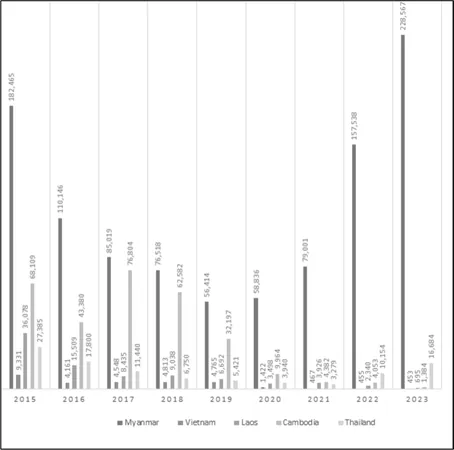
The Alarming Rise of Zoonotic Malaria in Southeast Asia: Key Insights and Threats
2025-07-04
Author: Jia
A Growing Public Health Crisis
Zoonotic malaria, driven primarily by Plasmodium knowlesi, poses a significant public health threat in Southeast Asia. The emergence of human infections dates back to 2004, with reported cases spanning across Malaysia, Thailand, Myanmar, Cambodia, Vietnam, and Laos. Despite a notable decline in global malaria cases, the persistence of zoonotic malaria complicates elimination efforts.
The Battle Against Malaria in the Greater Mekong Subregion
While countries like Thailand, Cambodia, and Vietnam set ambitious goals for malaria elimination by 2025, others like Laos and Myanmar target 2030. The ongoing political unrest in Myanmar has introduced complex challenges, leading to cross-border transmission that exacerbates the situation.
Malaysia's Struggle with P. knowlesi
Even after eliminating human malaria in 2018, Malaysia has seen a rise in P. knowlesi cases, postponing its eligibility for WHO's malaria-free certification. Recent statistics from 2023 revealed that all indigenous malaria deaths in Malaysia were linked to P. knowlesi, underscoring the urgency of the issue.
Understanding Zoonotic Transmission Dynamics
Zoonotic malaria occurs when malaria pathogens spill over from animal reservoirs, primarily monkeys, into humans. Regions with high monkey populations often coincide with human infection hotspots, illustrating the interconnectedness of wildlife and human health.
Challenges in Diagnosis and Treatment
Diagnosing zoonotic malaria remains a formidable challenge, particularly in areas where traditional microscopy is the norm. The WHO emphasizes that molecular methods, like PCR, are essential for accurate diagnosis. However, these technologies are often unavailable in rural regions, hindering timely intervention.
A Call for Comprehensive Research
To effectively combat zoonotic malaria, a systematic review of existing data is vital. The need for a comprehensive meta-analysis highlights the gaps in current research methodologies and sets the stage for more targeted control strategies that consider ecological and socio-economic factors.
Prevalence Data Insights
Recent analyses estimate that the prevalence of zoonotic malaria in humans across the Greater Mekong Subregion and Malaysia stands at approximately 8.5%. This figure, while alarming, underscores significant variations that complicate understanding the actual risk of transmission.
Socio-demographic Influences on Transmission
Age, gender, and lifestyle factors were identified as key determinants influencing the transmission of zoonotic malaria. Males, particularly between 21 and 40, showed significantly higher infection rates than females. Activities like forest work and movement patterns also play critical roles in exposure.
The Role of Monkeys in Disease Transmission
Among primate hosts, the prevalence of infection varies significantly. Long-tailed macaques and pig-tailed monkeys are notable reservoirs for P. knowlesi, contributing to the complex dynamics of zoonotic malaria. The proximity of these monkey populations to human habitats increases the risk of spillover events.
Addressing the Urgent Threat of Zoonotic Malaria
With an intricate web of interdependencies between humans, animals, and vectors, zoonotic malaria presents ongoing challenges. Public health strategies must adapt and strengthen to tackle the multifaceted nature of this emerging infectious disease. Enhanced diagnostics, robust surveillance, and community engagement are crucial to curtailing its spread and protecting vulnerable populations.


 Brasil (PT)
Brasil (PT)
 Canada (EN)
Canada (EN)
 Chile (ES)
Chile (ES)
 Česko (CS)
Česko (CS)
 대한민국 (KO)
대한민국 (KO)
 España (ES)
España (ES)
 France (FR)
France (FR)
 Hong Kong (EN)
Hong Kong (EN)
 Italia (IT)
Italia (IT)
 日本 (JA)
日本 (JA)
 Magyarország (HU)
Magyarország (HU)
 Norge (NO)
Norge (NO)
 Polska (PL)
Polska (PL)
 Schweiz (DE)
Schweiz (DE)
 Singapore (EN)
Singapore (EN)
 Sverige (SV)
Sverige (SV)
 Suomi (FI)
Suomi (FI)
 Türkiye (TR)
Türkiye (TR)
 الإمارات العربية المتحدة (AR)
الإمارات العربية المتحدة (AR)